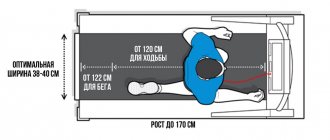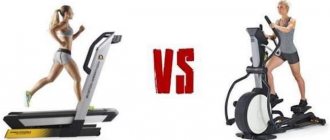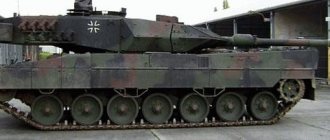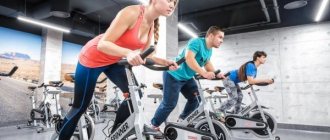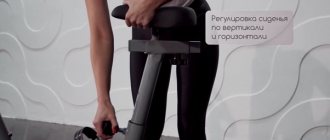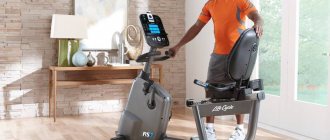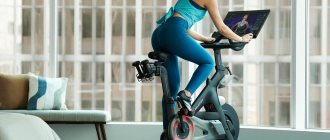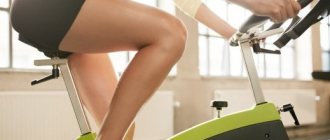Although the treadmill is a cardio machine that serves to strengthen the heart, respiratory system, lose weight, relieve stress and develop general endurance, exercise on it - running and walking - helps, first of all, to maintain tone and develop the muscular system.
Taking into account the specifics of the treadmill, the load is directed mainly to the lower part of the body.
Let's figure out which muscles are involved, how to regulate the load during training, and whether it is possible to pump up your legs on a treadmill.
Treadmill. What does she train in the lower body?
The main load that exercises on a treadmill provide is taken by the lower part of the body, which is quite logical. The following muscle groups perceive them most intensively:
- The buttocks, which remain among the strongest and largest in the human body. Their task lies in fixing the position of the body, the ability to tilt the pelvis in different directions, and their importance is confirmed by the presence of different programs for training this group.
- The biceps and quadriceps muscles of the thighs, which are responsible for bending the legs, straightening the knees, rotating the lower leg, and straightening the entire torso.
- The calf muscles, which help keep the human body in balance and are responsible for the rotation of the human foot.
- The anterior and posterior tibial muscles, which work in pairs and are responsible for the movement of the foot, fixing the latter while bending the leg forward.
- The muscles of the toes that are responsible for their flexion and extension.
The effectiveness of walking for burning calories
The higher the inclination angle, the greater the load the main muscle groups receive. Under an inclination, work is performed, the force vector of which differs from the direction of gravity.
The table presents calculated data during walking on an inclined surface.
| Distance (distance), m | Angle of inclination of the running belt, degrees | Energy consumption, kcal | |||||
| User weight, kg | |||||||
| 60 | 70 | 80 | 90 | 100 | 110 | ||
| 1500 | 1 | 3,96 | 4,95 | 5,5 | 6,05 | 6,6 | 7,15 |
| 1500 | 3 | 11,52 | 14,4 | 16 | 17,6 | 19,2 | 20,8 |
| 1500 | 5 | 18,72 | 23,4 | 26 | 28,6 | 31,2 | 33,8 |
| 1500 | 10 | 37,44 | 46,8 | 52 | 57,2 | 62,4 | 67,6 |
| 3000 | 1 | 7,92 | 9,9 | 11 | 12,1 | 13,2 | 14,3 |
| 3000 | 3 | 22,32 | 27,9 | 31 | 34,1 | 37,2 | 40,3 |
| 3000 | 5 | 38,16 | 47,7 | 53 | 58,3 | 63,6 | 68,9 |
| 3000 | 10 | 74,88 | 93,6 | 104 | 114,4 | 124,8 | 135,2 |
| 5000 | 1 | 11,52 | 14,4 | 16 | 17,6 | 19,2 | 20,8 |
| 5000 | 3 | 34,56 | 43,2 | 48 | 52,8 | 57,6 | 62,4 |
| 5000 | 5 | 56,88 | 71,1 | 79 | 86,9 | 94,8 | 102,7 |
| 5000 | 10 | 113,04 | 141,3 | 157 | 172,7 | 188,4 | 204,1 |
| 8000 | 1 | 19,44 | 24,3 | 27 | 29,7 | 32,4 | 35,1 |
| 8000 | 3 | 57,6 | 72 | 80 | 88 | 96 | 104 |
| 8000 | 5 | 95,04 | 118,8 | 132 | 145,2 | 158,4 | 171,6 |
| 8000 | 10 | 187,92 | 234,9 | 261 | 287,1 | 313,2 | 339,3 |
| 16000 | 1 | 38,16 | 47,7 | 53 | 58,3 | 63,6 | 68,9 |
| 16000 | 3 | 113,76 | 142,2 | 158 | 173,8 | 189,6 | 205,4 |
| 16000 | 5 | 189,36 | 236,7 | 263 | 289,3 | 315,6 | 341,9 |
| 16000 | 10 | 376,56 | 470,7 | 523 | 575,3 | 627,6 | 679,9 |
Walking on a treadmill. What muscles work in the upper body?
What muscles do I work when walking on a treadmill? At the same time, not only the muscles of the lower body are involved during running. The upper ones are also in good shape, although the load on them is lower. The following groups should be indicated here:
- The muscles of the arms, which are activated to maintain rhythm and maintain balance, as the movements go in the opposite direction (when the left leg moves forward, the corresponding arm moves backward and vice versa). Here the triceps, biceps, and shoulder girdle muscles withstand the greatest load.
- Core muscles that feel good after a long workout in the form of fatigue or “cloggedness”, which confirms their load.
- Abdominal muscles that help move your hips forward, maintain balance, protect against fatigue, and maintain correct running technique. During training, all types are involved (lower, lateral, intercostal), which contributes to complex development.
What does a treadmill train? The cardiovascular system
The cardiovascular system automatically responds to any loads that treadmills provide for walking, supplying certain muscle groups and internal organs with nutrients and oxygen. Regular aerobic exercise, which includes running, contributes to the overall strengthening of the circulatory system and heart. The latter is relevant in the conditions of a modern sedentary lifestyle. With regular training, the following positive effects have been clinically confirmed:
- improving the elasticity of blood vessels due to regular muscle contraction;
- expansion of peripheral vessels, which improves blood microcirculation and nutrition of internal organs;
- improvement of the condition of the heart due to additional periodic load on it (in principle, it is a hollow muscular organ that can be trained, like other muscle groups);
- an increase in lung volume, which helps improve oxygen supply to the brain and other internal organs;
- acceleration of recovery processes in the body;
- improvement of blood composition (increase in the number of red blood cells and hemoglobin, leukocyte activity);
- normalization of the nervous system, which simplifies the fight against stress and increases the speed of nervous reactions.
In fact, due to running and its positive effect on the muscles of the cardiovascular system, the general condition of the body improves.
The benefits and harms of running
What does running give us? Regular exercise can bring invaluable benefits to the body:
- Heart function improves. While running, even at a slow pace, your heart rate increases and your blood flow accelerates. This means that all organs and tissues receive more nutrition and can develop and function normally.
- The lungs are being trained. With increased breathing, residual air comes out that did not leave the lungs when exhaling (yes, we also have this in our bodies).
- The body's endurance increases, apathy and drowsiness disappear.
- Metabolism is normalized and calories are burned. This is especially important if you want to lose weight.
- Blood flow to the pelvic area is activated. This is useful for both women (normalizes the functioning of the genital organs) and men (improves erection).
In addition, psychologists say that running helps fight stress and depression. And this is true - during exercise, the body produces endorphin: the so-called hormone of happiness. Regular jogging can make a person more friendly, calm and sociable.
As for the harm of running, of course, like any type of exercise, it can have a negative effect on the body. However, its harmful effects are somewhat exaggerated: often in the specialized literature you can find “horror stories” that professional runners suffer from various diseases - they say that running takes away health, and does not add it.
Indeed, excessive physical exertion “to the point of wear and tear” can greatly undermine the body. Professionals train most of the day - it's their job. Of course, under such conditions, health suffers. You're not going to run for eight hours, are you? Therefore, if you have no contraindications to exercise and you have chosen a normal intensity of training and also follow the technique, there will be no harm.
What muscles work on a treadmill when the incline changes?
To increase the variety of workouts and increase efficiency, the machines allow you to adjust the incline angle. In mechanical and magnetic models this happens manually, but in electric ones it can be done automatically using the on-board computer. Typically, the adjustment range is 6-15 degrees, which is enough even for professional-level training. Using this option can significantly increase the load on muscles during training, providing the following positive effects:
- increasing the variety of workouts (you can set the “Hills” program, when the slope will periodically change, simulating descents and ascents);
- increasing overall endurance by changing the intensity of the load, which is difficult to achieve in a regular stadium;
- connect an additional power element, which will have a beneficial effect on muscles, joints and ligaments;
- increase in the number of calories burned;
- increasing overall movement coordination.
In general, increasing the inclination increases the load on the muscles of the calves, thighs, and shoulder girdle due to the need to help yourself with your hands when moving.
Treadmill that trains depending on the type of running
Another interesting point when answering the question, what does a treadmill train for, lies in the ability to work out different muscle groups with different intensities, allowing you to achieve the desired result and at the same time prevent severe overload. The latter is especially important in the first periods of training, when general adaptation of the body occurs. There are several types of treadmill running that are most popular today:
- jogging;
- running on hills;
- sprinting.
Slow jogging is the most popular option among beginner athletes. It does not require intensive involvement of the body muscles, so it is difficult to use it to build a relief corset. At the same time, such training provides several important undeniable advantages over other methods of running:
- improved endurance;
- strengthening the heart muscle;
- improving blood circulation and vascular condition;
- improvement of ligament condition.
If you are interested in which muscles work on a treadmill when jogging for the purpose of improving your health, then this option will be universal. The reason is the effective development of skeletal muscles, which are responsible for reaction, coordination, voluntary and involuntary movements. With age and a sedentary lifestyle, their weakness and decrease in strength and mass occur. Light, regular running helps maintain their quality and strength.
Training program
A lesson for a person with average physical fitness should be structured as follows:
- Warm up the joints - circular rotations of the legs, feet, pelvis - 5 minutes.
- Warm up on the treadmill – light jogging or brisk walking – 5-7 minutes.
- Health jogging - 20 minutes. During this time, you can run in any convenient way: jogging, jogging or fartel. At the same time, the average speed should be 5-8 km/h, and the maximum speed should be 8-11 km/h, depending on the level of physical fitness.
- Cool down – easy jogging or walking – 3-5 minutes.
A treadmill that helps you lose weight and train you while moving “through the mountains”?
If you want to do strength training while running, then a universal option would be to move at a large incline or simulate running on hilly terrain, when the position of the track will constantly change. This option uses a large number of fast-twitch muscle fibers, which increases their strength and stimulates overall growth. At the same time, there is a general reduction in the amount of fat tissue throughout the body, so it is difficult to answer a question like: “I have a treadmill, what is the first thing to lose weight?”
Running uphill can be considered additional strength training with weights, when the latter is the body that needs to be lifted up. Yes, such loads cannot be compared with a traditional gym, but this is enough to work out the entire complex of muscles.
Treadmill that trains you for short distance running
Any high-speed training actively engages fast-twitch fibers, which contributes to increased strength endurance and muscle tissue growth. At the same time, the legs, body and arms actively work here, which contributes to the harmonious development and strengthening of the body.
Walking and running on a treadmill to strengthen muscles
If you plan to use a treadmill to strengthen muscle mass, then it is enough to adhere to the following rules:
- increase the speed gradually;
- use load training several times a week (hill running, interval running, sprints);
- use weights for training;
- add strength exercises to your workouts;
- stick to a protein-based diet;
- Do regular strengthening exercises.
If you want to use a treadmill for weight loss, then it is additionally advisable to adhere to the following principles:
- go for a “jog” in the morning before breakfast, when the level of glycogen in the liver is minimal and the burning of excess fat increases;
- include casein protein in your diet in the evening, and consume BCAA amino acids in the morning;
- do strength training that will show the relevance and importance of muscles to the body;
- give up evening workouts.
At the same time, it is important to calculate your own diet in order to maintain a sufficient amount of protein intake and reduce the amount of carbohydrates.
Is it possible to pump up your legs on a machine?
Is it possible to increase muscle mass in the legs, is it possible to lose belly fat by working out on a treadmill, and what training options are most suitable for this? Let's look at three types of exercises on a treadmill and make a choice.
During interval training
Repeated alternation of two types of load - intense, with acceleration to the limit of capabilities, with running at an easy or medium pace at certain time intervals is called interval training.
3 interval training schemes on the treadmill here.
On an electric trainer, you can set all the parameters of such a workout to suit yourself, and the track itself will not allow you to cheat and make your life easier. Such classes are really very effective for:
- for weight loss and fat burning (especially in the lower back and abdomen);
- heart and vascular training;
- increasing muscle strength and endurance;
- variety and change of impressions when running in one place.
But if our goal is to pump up our legs, this is not your option. In addition, you should remember: such training is not recommended for beginners; they require considerable physical preparation.
Training on an incline
This program is more suitable for those who do not strive to increase muscle mass in the legs, but, on the contrary, to dry legs, strength and clear relief. That is, ideally, these are the lower limbs of professional athletes. Beauty and lightness are obvious, but the only muscles that grow under such loads are the calf muscles , the rest of the leg muscles do not sway.
The reason is that the calves belong to the class of slow fibers, requiring long loads at low intensity. A 40-minute jog three times a week can give you this result, and at the same time your abdominal shape will also improve. Attention! The change in the position of the canvas can be expressed either in degrees or as a percentage.
It's not the same thing. Interest must be calculated mathematically. To properly use all the functions of the simulator, you must first familiarize yourself with how to use the simulator.
When combining running and weight training
But this is exactly our case . But you also need to combine strength training with treadmill running wisely. How to exercise in order to not only maintain your muscle mass, but also increase it?
Running until exhaustion after strength training will give the opposite result: having completely used up the carbohydrate energy reserve glycogen in the gym, the body, with continued exercise, will begin to partially break down fat and muscle protein to produce energy - that is, dry out the muscles.
But if you, for example, run in the mornings as exercise on your simulator, and train with free weights three times a week in the evenings, this will ensure maximum muscle growth.
You will only spend glycogen, which can be replenished from session to session, and metabolism in the leg muscles loaded with such alternation will accelerate, which will contribute to the production of testosterone and muscle fiber growth hormone.
Don’t forget that regardless of the program you choose, you need to remember the 8 rules for effective exercise and be sure to follow safety precautions.
And also check out the most complete review of proper treadmill exercises.
For an even better understanding, watch some videos:
Here is a slightly controversial, but no less interesting material:
